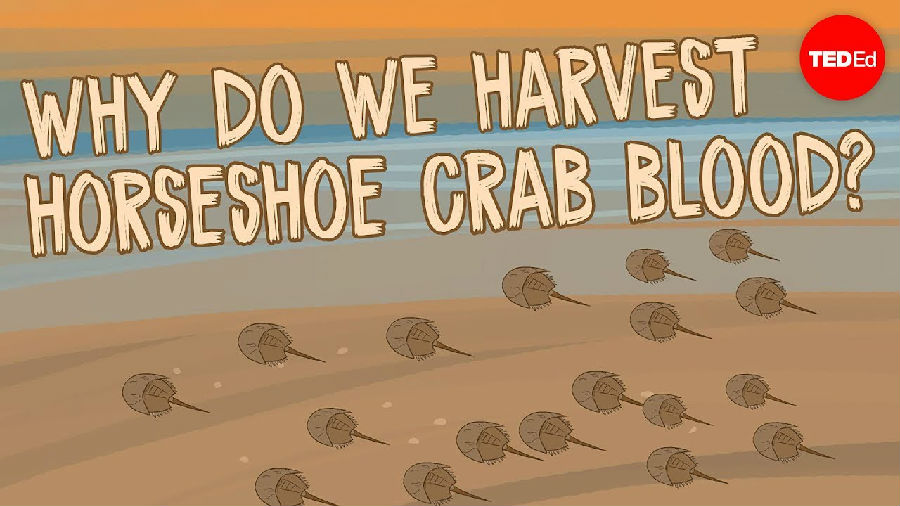(单词翻译:单击)
During the warmer months, especially at night during the full moon, horseshoe crabs emerge from the sea to spawn.
在较暖和的月份里,尤其是满月的夜晚,马蹄蟹浮出海水来产卵。
Waiting for them are teams of lab workers who capture the horseshoe crabs by the hundreds of thousands,
等待着它们的是实验室工作团队,他们会捕捉数十万只马蹄蟹,
take them to labs, harvest their cerulean blood, then return them to the sea.
将带它们到实验室,采集它们蔚蓝的血液,再将它们放回大海。
Oddly enough, we capture horseshoe crabs on the beach because that's the only place we know we can find them.
说来奇怪,我们在海滩上捕捉马蹄蟹,因为那是我们唯一所知能找到它们的地点。
A female horseshoe crab lays as many as 20 batches of up to 4,000 eggs on her annual visit to the beach.
一只雌马蹄蟹每年可在海滩产下多达20批,最多4000颗卵。
When the eggs hatch, the juvenile horseshoe crabs often stay near shore, periodically shedding their shells as they grow.
当卵孵化的时候,幼马蹄蟹常待在岸边,随着成长,周期性地脱壳。
Once they leave these shallow waters, they don't return until they reach sexual maturity ten years later.
一旦它们离开这些浅水区,直到十年后性成熟时才回来。
Despite our best efforts, we don't know where they spend those years.
即使竭尽所能,我们还是不知道它们在哪里度过年轻的岁月。
Though we've spotted the occasional horseshoe crab as deep as 200 meters below the ocean's surface,
虽然在海面下200公尺深处,我们曾偶然目击马蹄蟹,
we only see large groups of adults when they come ashore to spawn.
但我们只能在它们来岸边产卵时看到大群的成年马蹄蟹。
Horseshoe crab blood contains cells called amebocytes that protect them from infection by viruses, fungi, and bacteria.
马蹄蟹的血液里含有一种称为“变形细胞”的细胞,会保护它们不受病毒、真菌和细菌的感染。
Amebocytes form gels around these invaders to prevent them from spreading infections.
变形细胞会在这些入侵者周围形成凝胶,以防止它们扩大感染。
This isn't unusual. All animals have protective immune systems.
这并不稀奇。所有动物都有防御用的免疫系统。
But horseshoe crab amebocytes are exceptionally sensitive to bacterial endotoxins.
但马蹄蟹的变形细胞对于细菌的“内毒素”异常地敏感。
Endotoxins are molecules from the cell walls of certain bacteria, including E. coli.
内毒素来自包括大肠杆菌在内的某些细菌细胞壁的分子。
Large amounts of them are released when bacterial cells die, and they can make us sick if they enter the blood stream.
当细菌死亡时,大量内毒素被释出来,如果它们进入血液,可能使我们生病。
Many of the medicines and medical devices we rely on can become contaminated,
许多我们所仰赖的药物和医疗器械都可能受污染,
so we have to test them before they touch our blood.
所以我们需要在它们接触到血液前先测试。

We do have tests called Gram stains that detect bacteria,
我们确实有叫做“革兰氏染色剂”的检验能侦测细菌,
but they can't recognize endotoxins which can be there even when bacteria aren't present.
但它们无法识别出内毒素,即使细菌不存在,内毒素也会存在。
So scientists use an extract called LAL produced from harvested horseshoe crab blood to test for endotoxins.
所以科学家们从马蹄蟹血中提取出一种叫做LAL的提取物来检测内毒素。
They add LAL to a medicine sample, and if gels form, bacterial endotoxins are present.
他们将LAL加入药物样品,假如形成胶状,表示细菌内毒素存在。
Today, the LAL test is used so widely
现今,LAL测试使用非常广泛,
that millions of people who've never seen a horseshoe crab have been protected by their blood.
数百万从未见过马蹄蟹的人被它们的血液保护着。
If you've ever had an injection, that probably includes you.
如果你曾经打过针,你可能也包括在内。
How did horseshoe crabs end up with such special blood?
马蹄蟹怎么会有这种特别的血液呢?
Like other invertebrates, the horseshoe crab has an open circulatory system.
如同其他无脊椎动物一样,马蹄蟹有开放式循环系统。
This means their blood isn't contained in blood vessels, like ours.
意思就是它们的血不像我们那样装在血管里的。
Instead, horseshoe crab blood flows freely through the body cavity and comes in direct contact with tissues.
相反,马蹄蟹的血在体腔内自由流动,并且直接与身体组织接触。
If bacteria enters their blood, it can quickly spread over a large area.
如果细菌进入它们的血液,便能迅速扩散到大片区域。
Pair this vulnerability with the horseshoe crab's bacteria-filled ocean and shoreline habitats,
将这个弱点与马蹄蟹充满细菌的海洋及海滨栖地结合起来,
and it's easy to see why they need such a sensitive immune response.
就很容易看出为什么它们需要这么敏感的免疫反应了。
Horseshoe crabs survived mass extinction events that wiped out over 90% of life on Earth and killed off the dinosaurs,
马蹄蟹从消灭了地球上90%的生物、并杀尽恐龙的大灭绝事件中存活了下来,
but they're not invincible. And the biggest disruptions they've faced in millions of years come from us.
但它们并非无敌。数百万年来,它们面临最大的危机来自于我们。
Studies have shown that up to 15% of horseshoe crabs die in the process of having their blood harvested.
研究显示,高达15%的马蹄蟹在血液采集的过程中死亡。
And recent research suggests this number may be even higher.
而最近的研究表示,这个数字甚至可能还要更高。
Researchers have also observed fewer females returning to spawn at some of the most harvested areas.
研究者也发现在某些捕获马蹄蟹最多的地区,回来产卵的雌马蹄蟹变少了。
Our impact on horseshoe crabs extends beyond the biomedical industry, too.
我们对马蹄蟹的影响也延伸到生医产业之外。
Coastal development destroys spawning sites, and horseshoe crabs are also killed for fishing bait.
海滨发展破坏了产卵地点,马蹄蟹也被杀来做鱼饵。
There's ample evidence that their populations are shrinking.
有充分证据显示它们的族群正在缩小。
Some researchers have started working to synthesize horseshoe crab blood in the lab.
一些研究人员已经开始在实验室中合成马蹄蟹血。
For now, we're unlikely to stop our beach trips,
目前我们不太可能不去海滩收集马蹄蟹,
but hopefully, a synthetic alternative will someday eliminate our reliance on the blood of these ancient creatures.
但希望有一天,一种合成替代品的出现会终结我们对于这些古老生物血液的依赖。


